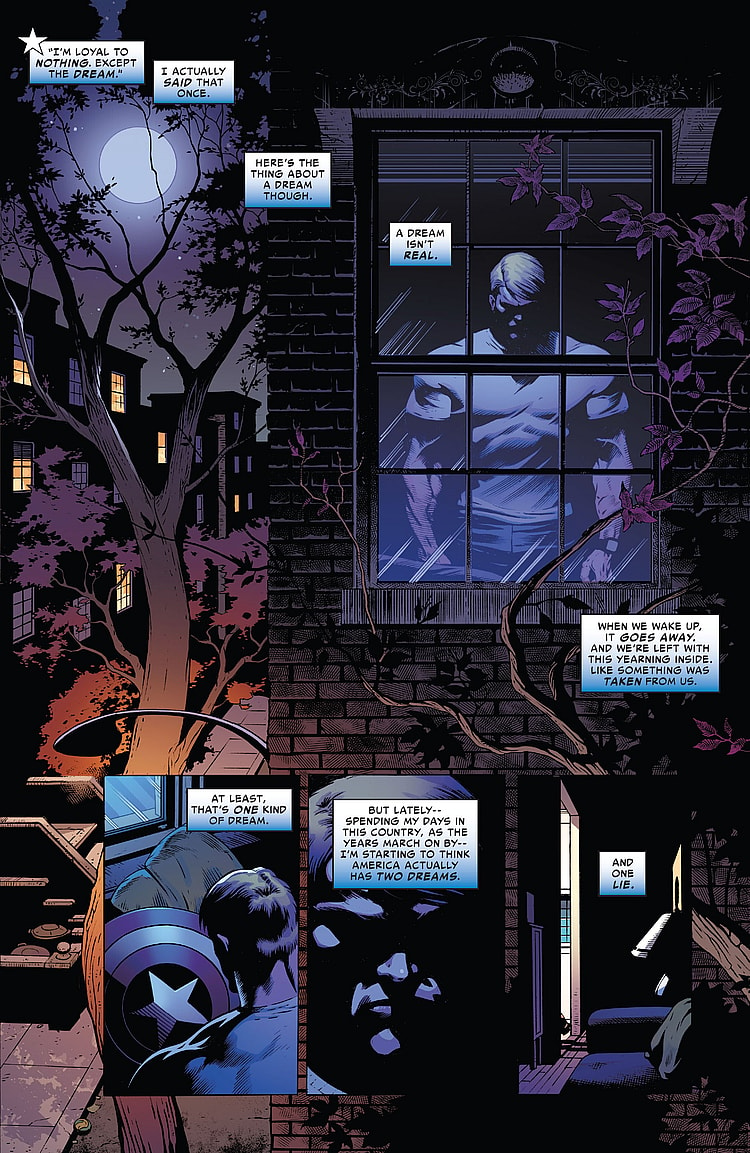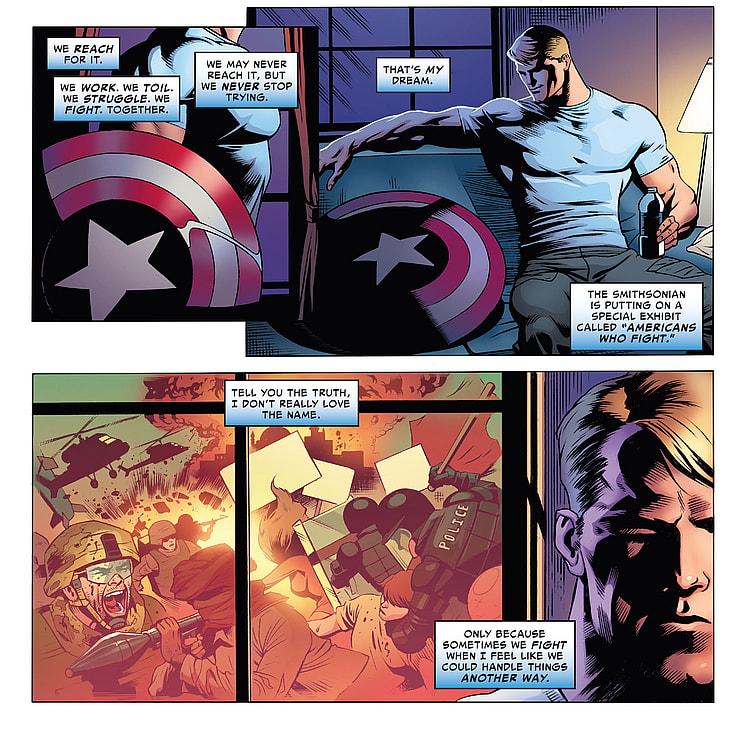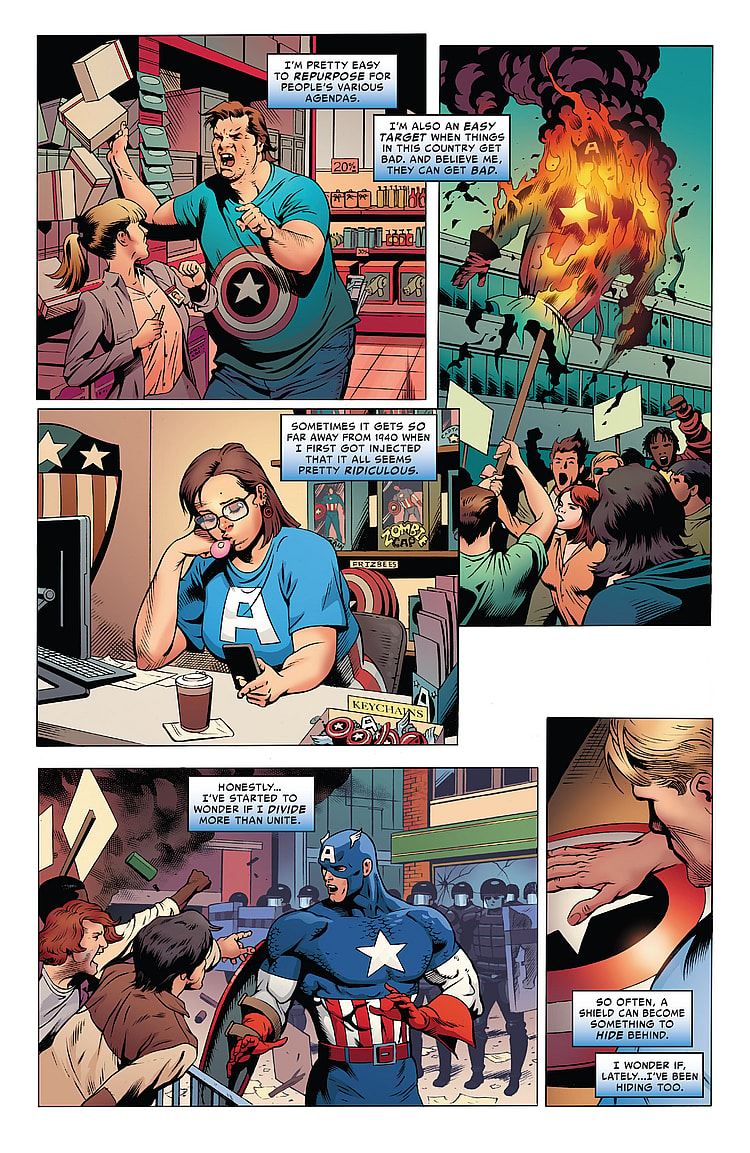Marvel Reveals Steve Rogers No Longer Believes In The American Dream In First Issue Of The United States of Captain America

Par for the course for contemporary Marvel writing, the premiere issue of the publisher’s star-spangled summer crossover, The United States of Captain America, has revealed that the original super-soldier himself, Steve Rogers, no longer believes in the concept of the American Dream.

Released on June 30th, the first issue of the Christopher Cantwell written and Dale Eaglesham illustrated miniseries opens (literally, the first page of the story) with a solemn Rogers staring out of his Brooklyn apartment and looking back on his past career as the Star-Spangled Avenger.
Beginning with a memory of his now iconic line, “‘I’m loyal to nothing except the dream,” uttered in admonishment of a warmongering US military general during an investigation into the origins of jingoistic supervillain Nuke (Daredevil Vol. 1 #233), Rogers finds himself in disbelief at how “I actually said that once.”

“Here’s the thing about a dream though. A dream isn’t real,” the hero continues.” When we wake up, it goes away. And we’re left with this yearning inside. Like something was taken from us.”
Rogers then asserts, “at least, that’s one kind of dream,” before mulling on how, “lately — spending my days in this country, as the years march on by — I’m starting to think America actually has two dreams. And one lie.”

Rogers then explains, “The first American Dream is the one that isn’t real. It’s the one some people expect to just be handed to them, and then get angry when it disappears, when the truth is, it never really existed in the first place.”
Continuing, Rogers then describes how “Germans have this neat word, ‘Fernweh.’ It means ‘a longing for nostalgia, for a place you’ve never been, or for a place that might not even exist at all.’”
“We have a word for this in the states,” he declares. “Americana.”

Taking a sponge to his dirty shield in an effort to clean it up before it’s potentially given to The Smithsonian to be put on display (in yet another trite attempt to force some sort of synergy between the comic books and the Marvel Cinematic Universe), Rogers goes on to note that “This is the white picket fence fallacy that, if we’re not careful, becomes nationalism. Jingoism.”
“That dream isn’t real. It never was,” he argues. “Because that dream doesn’t get along nicely with reality. Other cultures. Immigrants. The poor. The suffering. People easily come to be seen as ‘different’ or ‘unamerican.’ The white picket fence becomes a gate to keep others out.”
He adds, “We’re at our best when we keep no one out. A good dream is shared. Shared radically. Shared with everyone. When something isn’t shared, it can become the American lie.”

Looking upon the pennant of his former World War 2 division, the real-world 1st Infantry, 26th Regiment, otherwise known as the Blue Spaders, Rogers expounds, “The lie is a real problem, because it comes in the form of an empty promise.”
“A while back, we told the world they could come here for a better life. But too often we turn our backs on them,” thinks Rogers. “Instead of a dream, they get handed a raw deal.”
The first Avenger then shifts his thoughts to “the second dream,” noting that “this one’s real, but we don’t hold it. Or own it. Heck, we can’t even touch it.”

“We reach for it,” he proclaims. “We work. We toil. We struggle. We fight. Together. We may never reach it, but we never stop trying. That’s my dream.”
Speaking to the plot of the miniseries, Rogers goes on to recap how “The Smithsonian is putting on a special exhibit called “Americans Who Fight” before lamenting how he didn’t “really love the name” because “sometimes we fight when I feel like we could handle things another way.”

Rogers’ mind soon turns to images of the yellow dress worn by Rosa Parks on the day of her now historical bus ride, a jacket bearing the symbol of the United Farm Workers union, what can be assumed to be Abraham Lincoln’s top-hat, a megaphone, and the Woolworth’s diner wherein the Greensboro sit-ins took place, all of which lead the Captain to share, “In my mind, there were Americans who fought, sure, but also reached. They laid themselves bare.”
“And they did it without serums or powers or metal suits,” he admires. “The museum wants to put my shield on display. They have an old replica, but they believe the real deal will mean more to people. But unlike those other folks – the ones who reached with selfless clarity — I find myself too often stripped of what I’m supposed to stand for.”

Turning to images of modern day Americans, Rogers admits, that his image is not only “pretty easy to repurpose for people’s various agendas,” but “also an easy target when things in this country get bad.”
“And believe me. They can get bad,” he asserts. “Sometimes it gets so far away from 1940 when I first got injected that it all seems pretty ridiculous.”
“Honestly…I’ve started to wonder if I divide more often than unite,” he concludes, just moments before an unknown stranger dressed as Captain America breaks into his home and puts an end to his inner monologue. “So often, a shield can become something to hide behind. I wonder if, lately…I’ve been hiding too.”

What do you make of Rogers’ outlook on the American Dream? Let us know your thoughts on social media or in the comments down below!
